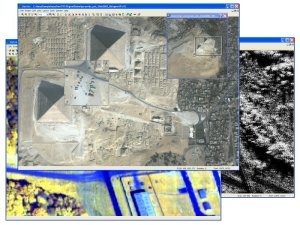Opticks

Welcome to Opticks
Opticks is an expandable remote sensing and imagery analysis software platform that is free and open source. If you are interested you can learn about the history of Opticks.
If you’ve used commercial tools like: ERDAS IMAGINE, RemoteView, ENVI, or SOCET GXP, then you need to give Opticks a try. Unlike other competing tools, you can add capability to Opticks by creating an extension. Opticks provides the most advanced extension capability of any other remote sensing tool on the market.
Features
- Free and open source
- Supports the following file formats: NITF 2.0/2.1, GeoTIFF, ENVI, ASPAM/PAR, CGM, DTED, Generic RAW, ESRI Shapefile, HDF5, AVI, MPEG, JPEG, GIF, PNG, BMP
- Zoom, pan, rotate spatially large datasets
- Quickly layer GIS features, annotations, results, and other information over your data to provide context
- Many image display controls such as colormap, histogram, transparency, etc.
- Support for datasets larger than four gigabytes
- Analysts can quickly combine steps using graphical wizards
- Support for processing data in its native interleave of BIP, BSQ or BIL
- Get extensions to drop in new capability.
History of Opticks
Backstory
Opticks was originally developed by Ball Aerospace for the US Air Force, specifically the National Air and Space Intelligence Center (NASIC) starting in the Spring of 2000. It was originally created for hyperspectral analysis, but was designed to be easier to use than ENVI, the tool of choice for researchers at the time. Opticks is meant to be used for non-literal exploitation as opposed to geospatial imagery analysis performed by tools such as GRASS and QGIS. Ball Aerospace and the Air Force started working jointly in 2006 to release the core application into the open source, excluding some of the processing algorithms. This was accomplished to great fanfare in December 2007. Both Ball Aerospace and the Air Force continue to support this open-source effort.
Since the original open-source release of Opticks, Ball Aerospace and the Air Force have worked to release some previously closed-source Opticks extensions. Specifically, the IDL Scripting and Spectral Processing extension were transitioned from closed source extensions and brought out into the open source. In a demonstration of our commitment to open source, the Python Scripting extension was developed as open source from day one.
Where did the name come from? Isn’t it mis-spelled?
We were looking for a name that was unique and easy to remember. We also wanted it to have something to do with what the application does, meaning imagery analysis. Someone mentioned that Isaac Newton’s original book on optics and refraction of light was called Opticks. So, we decided that would be a pretty good name, because who doesn’t like Isaac Newton. So, that’s how we ended up with the name. And as you can now see, it is not mis-spelled.
